Clash of Titans
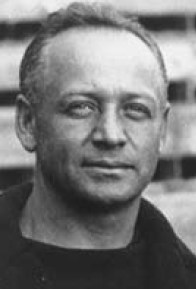

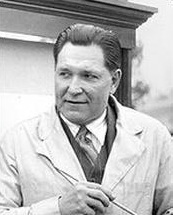
L-R: John Bender, Pop Warner, William Dietz
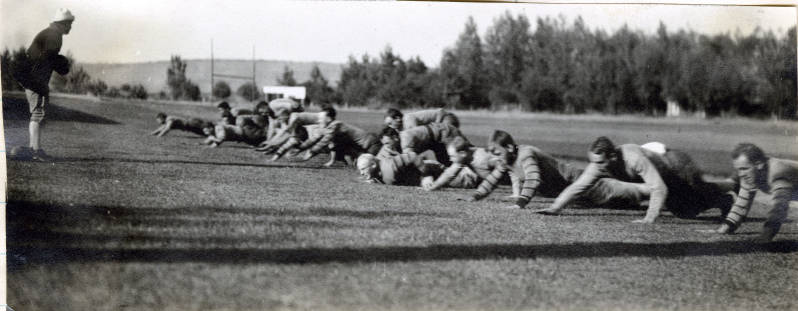
Training camp at Liberty Lake (WSC Digital Libraries)


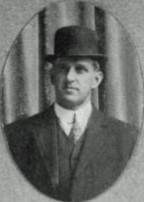
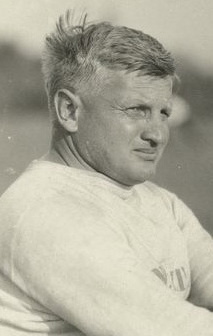
L-R: Jack Applequist, Asa "Ace" Clark, Doc Bohler, Hugo Bezdek
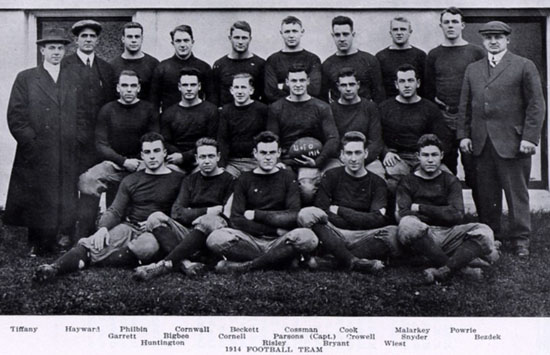
1915 Oregon Football Team (University of Oregon Oregana Yearbook 1916)
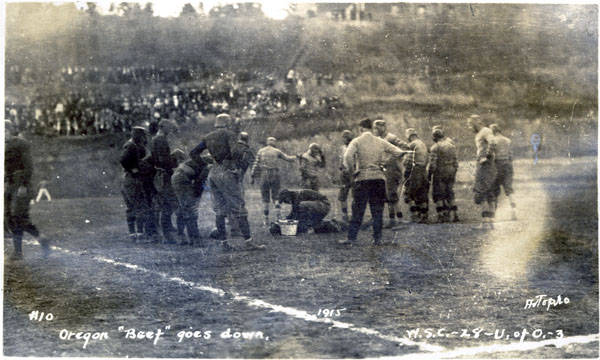
An injured Oregon player is attended to during the game. WSC wore the light striped jerseys.
(WSC Digital Libraries)
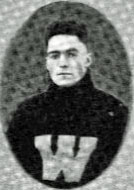
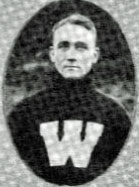
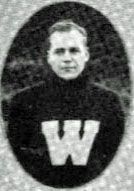

L-R: Dick Hanley, Benton Bangs, Bull Durham, Carl Dietz
(All pictures from the 1916 Rose Bowl program.)

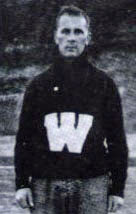

L-R: Harry Applequist, Asa Clark, Clarence Zimmerman
(WSC Digital Libraries)
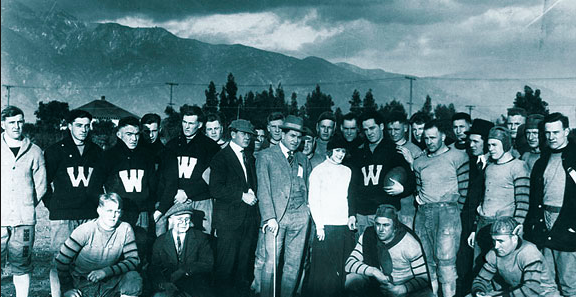
Nattily dressed Coach Dietz and his players at a practice in Pasadena before the Rose Bowl game.
(WSC Digital Libraries)
Games featuring a future Hall of Fame coach on each sideline.
October 9, 1915: Oregon @ Washington State
William Dietz vs Hugo Bezdek
Washington State College was the neglected stepchild of its state's higher education system. Founded in 1891 as a land-grant institution on the eastern edge of the state in Pullman, Washington Agricultural, as it was originally named, was 285 miles from Seattle, the home of the University of Washington.
Washington State began playing football in 1894 as an independent. The Warriors' glory years were 1906-09 during which they went 21-2-2. However, they didn't have a winning season from 1910-1914, the best mark being 4-4 in 1913.
John Bender had two stints as WSC head coach: 1906-07 and 1912-14. But after Washington humiliated the Warriors 45-0 to end the 1914 season, Bender was told to find employment elsewhere.
What coach could be persuaded to travel to the far northwest corner of the nation to take over the WSC program? President Enoch Bryan sent a telegram to the most famous coach in the land, Glenn "Pop" Warner, at the Carlisle Indian College in Pennsylvania. Bryan asked Warner to recommend someone for the WSC job.



L-R: John Bender, Pop Warner, William Dietz
Warner's choice was 30-year-old William "Lone Star" Dietz, a tackle on his Carlisle team from 1909-12 who became Pop's assistant at the Indian college. While Dietz's pedigree seemed impeccable, Bryan wondered how a man who was half Native American would be received in Pullman. The president set aside his trepidation and offered Dietz a contract that would pay him $2,250 per season–roughly what the top professors were paid in those days.
When Dietz arrived in Pullman in early September, he met with his players, who had been summoned to return to campus early. He quickly understood why WSC had not done well the year before. None of the players were over 180 pounds. Perhaps two or three were true athletes. So he took them all on a train 90 miles to a resort on Liberty Lake, just inside the Idaho border.
Dietz had prepared a detailed daily schedule. Each day started with traditional calisthenics followed by a team run through the nearby hills. After a tough morning workout, the team enjoyed a multi-course meal prepared by a special cook. The afternoons included relay races across an obstacle course in the woods as well as time for players to enjoy individual pursuits. Dietz wanted the players to bond together as he identified leaders.

Training camp at Liberty Lake (WSC Digital Libraries)
Eventually, Dietz introduced the techniques and plays he learned from Warner at Carlisle. One was the "rolling block" whereby players would drop down and "roll" into the opponents' legs, then jump back up and look for another man to block. Another concept from Warner's fertile brain was the "pulling lineman." When the ball was snapped, an offensive lineman stepped back, turned, and sprinted down the line of scrimmage to get an extra blocker into a sweep.
When the team returned to campus, they were finally issued their familiar wool pants and leather helmets. With players wondering, "When will we actually play football?" Dietz split his squad into offensive and defensive units, a new concept to players used to staying on the field the entire game.
The coach wanted his team to run what today is called the "no-huddle offense." When the play ends, line up quickly while the quarterback calls out the next play and run it before the defense can get set. This is where the conditioning drills would pay dividends.
The four backs lined up in the single-wing formation that Warner invented, although it was not given that name at the time. With no one under center, the ball could be snapped to either the tailback or the fullback, both of whom lined up four-five yards behind the center. The quarterback (or "blocking back") lined up right behind the lineman either to the right or the left of the center. The wingback lined up just outside the right or left end. From that position, he could lead the interference or come back for a handoff or pitchout.




L-R: Jack Applequist, Asa "Ace" Clark, Doc Bohler, Hugo Bezdek
With the opening game against Oregon rapidly approaching, Dietz installed only a handful of plays. As the season went on, he would add variations. Each play had a name. For example, "Apple" came from lineman Jack Applequist to indicate that Jack would be the pulling lineman on a sweep. The sweep in the other direction was dubbed "Clark" in honor of G Asa Clark. Each name was followed by the snap count.
Assistant coach Doc Bohler schooled the defense. The Carlisle approach was to confuse the offense by having defenders move constantly right up to the snap of the ball. The rules required three linemen in a down and set position when the ball was snapped but said nothing about what happened before the snap. As with the offense, the defensive plays had names. Doc's most popular creation was "Log-jam." Knowing his players would be facing teams much larger than them, he lined up defenders both inside and outside the tackles and then pinched everything toward the middle. Inside linemen would shoot into the gaps, staying low to prevent being chopped down by blockers.
Oregon's third-year coach Hugo Bezdek was born in Prague before immigrating to the U.S. as a child. He learned football playing fullback for the University of Chicago's legendary coach Amos Alonzo Stagg. After coaching Arkansas from 1908-1912, where he coined the nickname "Razorbacks," Bezdek had defeated Washington State in 1914 7-0 in Portland. Bezdek's team had developed a reputation for playing dirty.
Bezdek sent a scout to the annual Washington State alumni game, which the current squad won by only 3-0 albeit on a muddy field after a rainstorm. The scout told Bezdek that "Washington State will not be a factor." However, the scout had watched only a few early plays before retreating to a local restaurant to avoid the weather.
Bezdek was so confident of victory that he announced he would hold out several key players. He told an Oregon paper, "I will not use my Captain and start QB Cornell in the game, unless needed in a pinch."

1915 Oregon Football Team (University of Oregon Oregana Yearbook 1916)
Every Oregon lineman weighed over 190lb. Even if Coach Dietz moved his fullback, senior Carl Dietz (no relation to the coach), to the line, the Warriors would still average only 175lb.
Addressing the crowd at the pep rally the night before the game, team captain Carl Dietz expressed confidence. "Oregon has a fast and heavy team. But we have an entirely new system that looks pretty good to me. I put the odds at being fairly even."
The game was played under cloudy skies with temperature in the mid-70s. A crowd of 1,200, mostly students, gathered in 3,000-seat Rogers Field.
Defenses Prevail
The first series of plays set the tone for the afternoon. The Oregon receiver took Dietz's kickoff and was dropped immediately on the nine. The WSC defensive unit raced onto the field, eager to show what they had learned in training camp. On the first snap, the light but quick Warrior linemen shot the gaps and dove at the legs of the offensive linemen, creating a logjam that made it impossible for the running back to gain any yardage.
After huddling, the Oregon offense lined up as the defenders constantly shifted around from side to side and from down in a stance to standing up. How were the blockers supposed to block someone who wouldn't hold still? The result was another loss of yardage. The confused substitute quarterback looked to Bezdek on the sideline for guidance as to what to call on 3rd-and-14. His coach screamed at his players to stick to the game plan.

An injured Oregon player is attended to during the game. WSC wore the light striped jerseys.
(WSC Digital Libraries)
The next play was a sweep intended to pit the bigger Oregon linemen against smaller defenders. But the Warrior linemen held their counterparts in place on the line of scrimmage. As the backs sprinted to the side, they were met by the speedy WSC linebackers and secondary. As the Webfoots fullback leading the interference prepared to block the nearest defender, RHB Dick Hanley, his target dropped to the ground and rolled into the fullback's legs, sending him sprawling. Hanley immediately hopped to his feet and tackled the ball carrier.
WSC Scores First
Oregon punted to speedy RB Benton Bangs, who caught the ball at his 30 and zipped forward. Rolling blocks cut down the coverage team until Bangs was tackled at midfield. Coach Bezdek raced onto the field, screaming at his players as an entire new eleven took the field for WSC.
As the WSC offense lined up without a huddle, QB Bull Durham called "Apple-3." At the snap, the offensive linemen dove into the legs of the men opposite them. The ball went directly to Bangs as Durham faked in the other direction. Behind the pulling linemen and the other backs, Benton turned the corner and rambled 40y before being tackled from behind.
The Oregon defenders had to hustle to get into position as WSC rushed to the line of scrimmage and snapped the ball to FB Dietz who smashed 10y to put the ball inside the 10. Two plays later, backup FB Basil Doane took the snap, put his head down, and slammed into the line. He and his convoy of blockers pushed three defenders backward until Doane was in the end zone. WSC 7 Oregon 0 after just six minutes of playing time.
The home team fans erupted in joy, hardly able to believe how easily their heroes had scored. Coach Bezdek, realizing he had grossly underestimated this WSC team, told his star QB Anson Cornell to warm up.
Starting from their 25 after the kickoff return, the Oregon linemen, who had yet to get a respite, continued to be frustrated by the constant movement of the WSC defenders, who had been on the sidelines during the scoring drive. Once again, the Webfoots went three-and-out. The fast-paced WSC offense moved quickly to the Oregon 35 before the defense finally held them on downs.




L-R: Dick Hanley, Benton Bangs, Bull Durham, Carl Dietz
(All pictures from the 1916 Rose Bowl program.)
"Bad Apple-3" Doubles WSC Lead
Neither team threatened again until midway through the second quarter when WSC reached the Oregon 40 and pulled out a special play called "Bad Apple-3." The snap went to G Harry Applequist who lateraled to Bangs sprinting to the right. As they had throughout the possession, blockers hurried to lead the sweep. But Bangs suddenly stopped, turned, and threw the ball across the field to a wide-open Dietz in the end zone. 14-0 WSC after the conversion.
All the WSC players jumped up and down as they ran to the sidelines except for one. Three Oregon linemen had ganged up on WSC Captain Asa Clark on the touchdown play, severely injuring his shoulder. If any official noticed the incident, he didn't call a penalty. Clark struggled to the bench, unable to raise his right arm.
Bezdek Calls on First Stringers
Getting desperate, Bezdek sent several of his top players who hadn't even dressed for the game to the locker room to suit up.
Figuring Oregon would pass more, Dietz changed his defensive scheme. He dropped back four linebackers and three defensive backs. Oregon tried to counter WSC's pre-snap movement by going to a quick count.
The WSC linebackers shot the gaps and forced Cornell to scramble to his right only to be tackled at the line of scrimmage. "What the hell was that?" he yelled at his blockers. "Can't you stop a bunch of farm boys?" In response to his comment, the defenders began to make animal noises just prior to the snap. On second down, Cornell couldn't even start to run as two defensive linemen smashed a hole in the blocking that was filled by a speedy linebacker who leveled the quarterback.



L-R: Harry Applequist, Asa Clark, Clarence Zimmerman
(WSC Digital Libraries)
Oregon Finally Scores
The Webfoots had yet to make a first down. However, they were able to put points on the board before halftime thanks to a break. One of WSC's younger players lined up on the wrong side of the field, allowing an Oregon runner to streak across midfield for the first time in the game. The player who made the mistake brought him down just inside the 40.
After two incomplete passes, Oregon ran the ball to the middle of the field to give their kicker a better angle. Hutchinson nailed the field goal to make the score WSC 14 Oregon 3 at halftime. Dietz saw several of Oregon's biggest players immediately dropped to the ground instead of heading to the locker room. The WSC coach also noticed that there were more fans in the stands now than at the beginning of the game.
On the other side, Doc Bohler noticed how badly injured Clark was and ordered him to sit out the second half. When Asa objected, Coach Dietz told him, "I need you on this team for the entire season. It won't kill you to sit one half."
Bezdek Goes All Out
Oregon started the second half with all their best players in the lineup. Bezdek spread his defense wider and stationed more men closer to the line of scrimmage. The ploy worked as WSC's first possession quickly ended in a punt.
Bezdek had made offensive adjustments also. Now his linemen stood straight up at the snap and used their arm strength to keep rushers at bay. The result was a 7y run on the first play–Oregon's biggest gain of the afternoon. On second down, with the linebackers staying tight to protect against the run, Cornell completed a pass for 7y for the visitors' initial first down of the game.
Two plays later, Cornell threw a beautiful pass just before the blitzing linebackers arrived for a gain to the WSC 40. But two short runs and an incompletion brought the kicker back onto the field. This time he missed to keep the score 14-3.
The WSC offense returned to its first half form. Sticking to the ground, they traveled relentlessly to the Oregon 20. At that point, Bezdek called a timeout to give his men a rest.
More WSC Trickeration
Dietz pulled out another surprise. He signaled for a play called "the reverse" that had been added to the game plan just a few days before. The ball was snapped to Bangs who started behind his blockers in one direction. But RE Clarence Zimmerman turned around from blocking his man and took a handoff from Bangs. Zim raced unnoticed and untouched down the sideline into the end zone. 21-3 WSC
Everyone in the stands except the 200 Oregon fans were jumping up and down and screaming. The only person on the WSC side of the field who was not excited was Coach Dietz, who continued to talk to individual players on the sideline.
Another WSC TD
By the fourth quarter, the exhausted Oregonians could barely mount an offense. With Dietz substituting freely, Cornell led a march deep into WSC territory. Noticing the left defensive back step toward the line as if anticipating a run, Cornell called a pass play. He was hit just as he released the ball. When he heard the cheers of the crowd as he lay on the ground, he just knew his receiver was scoring a touchdown. But he quickly realized that the elation came from the WSC sideline. Zimmerman had stepped back from the line and tipped the pass into his own hands. He then sprinted 80y for his second touchdown of the day.
The rest of the game was uneventful. To quote a newspaper account the next day, "the Oregon game went to pieces after this reverse, defensive playing and kicking out of danger at every opportunity being the plan of battle." WSC outgained the visitors by a whopping 378y to 112. Final score: WSC 28 Oregon 3
Post Game
Bezdek congratulated Dietz as they shook hands at midfield. "I gotta say, Dietz, your boys played a hell of a game." Dietz graciously replied, "We had a good day."
Dietz went from player to player in the locker room, offering his personal congratulations and citing a specific contribution each man made to the victory. One player called out, "Not a bad day for a bunch of 'farm boys.'"

Nattily dressed Coach Dietz and his players at a practice in Pasadena before the Rose Bowl game.
(WSC Digital Libraries)
Reference:
Chance for Glory: The Innovation and Triumph of the Washington State 1916 Rose Bowl Team, Darin Watkins (2015)
Chance for Glory: The Innovation and Triumph of the Washington State 1916 Rose Bowl Team, Darin Watkins (2015)